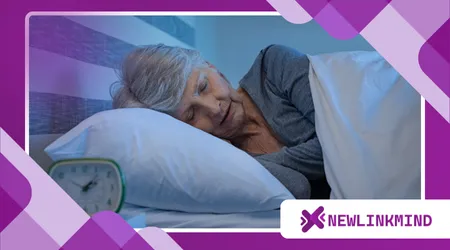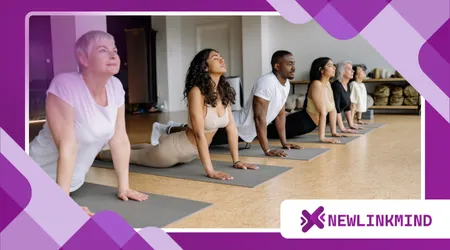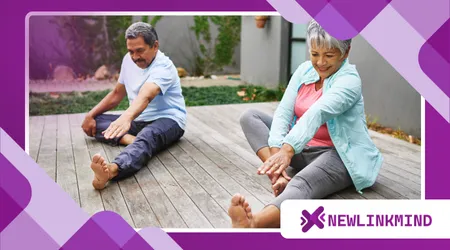How Yoga Improves Sleep Quality for Seniors

Anúncios
Yoga improves sleep quality for seniors. As we age, our bodies change, and so do our sleep patterns.
Many seniors find themselves waking up frequently, struggling to fall back asleep, or feeling less rested despite spending adequate time in bed.
This isn’t just a minor inconvenience; chronic poor sleep is linked to a host of health issues, including decreased cognitive function, a weakened immune system, and increased risk of heart disease.
The sleep puzzle for seniors is complex, often involving a combination of physical discomfort, stress, and lifestyle factors.
Traditional sleep aids can offer temporary solutions, but they often fail to address the root causes of the problem.
Anúncios
How Yoga Transforms the Sleep Landscape
Yoga offers a gentle, yet profound, way to re-establish a healthy relationship with sleep.
Unlike high-impact exercises that can be too strenuous, yoga’s mindful movements and controlled breathing techniques are perfectly suited for the senior body.
It’s not about complex poses or acrobatic feats; it’s about a mindful connection between breath and movement.
Anúncios
This practice provides a pathway to calming the nervous system, releasing physical tension, and quieting the mental chatter that often keeps us awake.
The consistent practice of yoga helps regulate the body’s natural sleep-wake cycle, known as the circadian rhythm, making it easier to fall asleep and stay asleep.
Beyond the Poses: The Science of Restorative Sleep
The power of yoga extends far beyond the physical poses. The deep breathing exercises, or pranayama, are key to its effectiveness.
By engaging in slow, rhythmic breathing, we activate the parasympathetic nervous system, the body’s “rest and digest” mode.
Read more: Yoga for Seniors: Finding the Right Style for You
This counteracts the sympathetic nervous system, which governs our “fight or flight” response and can be overactive in times of stress.
A calm nervous system is a prerequisite for sound sleep.
Research supports this; for instance, a 2017 study published in the Journal of the American Geriatrics Society found that older adults who participated in a yoga program experienced significant improvements in sleep quality and duration.
It’s this direct impact on the nervous system that highlights how yoga improves sleep quality for seniors.

Tailoring a Practice for Better Rest
The beauty of yoga is its adaptability. A senior’s practice might look completely different from a younger person’s, focusing on gentle, supported poses that are both safe and effective.
Poses like supported child’s pose, legs-up-the-wall, and gentle twists can be particularly beneficial for promoting relaxation.
Read here: Chair Yoga for Seniors: Stay Active Without Strain
Using props like bolsters, blankets, and chairs makes these poses accessible and comfortable.
The goal is not to push the body to its limits, but to encourage a state of deep relaxation.
Imagine the body as a tightly wound spring; a gentle yoga practice is like slowly and mindfully releasing that tension, allowing it to unwind completely before sleep.
A Nighttime Routine for Tranquil Slumber
Incorporating a short yoga session into a nightly routine can work wonders.
A simple, 15-minute practice right before bed can signal to the body that it’s time to transition from a day of activity to a night of rest.
This routine becomes a ritual, a mental cue for the brain to slow down. One example is an elderly woman named Martha, who used to struggle with restless legs and racing thoughts.
She started a gentle evening yoga routine that included seated forward folds and a simple meditation, and she found that her legs no longer twitched and her mind was quiet.
A study found that over 55% of people aged 65 and over report having difficulty sleeping at least once a week.
This staggering number underscores the need for effective, non-pharmaceutical solutions, which is precisely where yoga improves sleep quality for seniors.
A Holistic Approach to Well-being
It’s crucial to understand that yoga’s benefits for sleep are part of a larger picture of overall well-being.
A consistent practice improves mobility, reduces aches and pains, and enhances mental clarity. A body that feels better is more likely to sleep better.
It’s a virtuous cycle: improved sleep leads to a more energized and balanced day, which in turn supports a more restful night.
See how interesting: 5 Calming Mantras for Senior Meditation
The practice of mindfulness, a core component of yoga, teaches individuals to be present and to let go of worries about the past or anxieties about the future.
This mental decluttering is arguably one of the most significant factors in promoting deep, restorative sleep. The power of a quiet mind cannot be overstated.
The Breath as Your Sleep Guide
The breath is the bridge between the mind and body. In yoga, we consciously use the breath to influence our state of being.
Techniques like Nadi Shodhana (alternate nostril breathing) or Bhramari (bumblebee breath) can be especially calming.
A senior gentleman, formerly a busy executive, struggled to disconnect from work thoughts.
His instructor introduced him to slow, deep belly breathing, and he found that this simple practice became his nightly anchor.
The deep, full breaths signaled to his body to relax, transforming his once-restless nights into peaceful ones.
It is through these targeted breathing exercises that yoga improves sleep quality for seniors on a physiological level.

Yoga Poses for Better Sleep
| Pose (Asana) | Description | Benefits for Sleep |
| Viparita Karani (Legs-Up-the-Wall) | Lying on your back with legs propped against a wall. | Calms the nervous system, relieves tired legs, and reduces anxiety. |
| Balasana (Child’s Pose) | Kneeling with forehead on the mat, arms stretched forward or alongside body. | Gentle forward fold that soothes the mind and body, releases back tension. |
| Supta Baddha Konasana (Reclined Bound Angle) | Lying on your back with soles of feet together and knees falling open. | Opens hips, releases tension in the groin and lower back, promotes deep relaxation. |
| Savasana (Corpse Pose) | Lying on your back with arms and legs extended, palms facing up. | The ultimate relaxation pose, allows the body and mind to fully absorb the benefits of the practice. |
Making It a Habit, Not a Chore
Starting a yoga practice shouldn’t feel like another item on a to-do list. The key is consistency over intensity.
Even a few minutes a day can make a difference. The gentle, cumulative effects build over time. It’s a journey of self-discovery and self-care, not a race.
The remarkable thing is how yoga improves sleep quality for seniors not just by addressing one symptom, but by nurturing the entire person.
By making it a regular part of their routine, seniors can rediscover the simple joy of a deep, uninterrupted night of sleep.
Wouldn’t it be wonderful to look forward to bedtime again? The journey to restful sleep is within reach, one mindful breath at a time.
Final Thoughts on Restful Nights
The undeniable link between physical movement, mental calm, and restorative sleep is a powerful testament to the wisdom of yoga.
For seniors seeking a natural, sustainable solution to sleep challenges, this ancient practice offers a compassionate and effective path forward.
The gentle movements, conscious breathing, and mindful relaxation are all integral parts of how yoga improves sleep quality for seniors.
It’s not just a set of exercises, but a way of living that honors the body’s need for rest and rejuvenation.
Frequently Asked Questions
What type of yoga is best for seniors?
Gentle Hatha, Restorative, and Chair Yoga are excellent choices. These styles focus on slower movements, longer holds, and use props for support, making them safe and accessible.
How often should a senior practice yoga for better sleep?
Even a daily 15-20 minute practice can be highly effective. Consistency is more important than duration or intensity. A short, gentle routine before bed can be a powerful tool.
Is it safe for seniors with mobility issues?
Yes, with proper modifications. A qualified instructor can adapt poses using props like chairs, blankets, and blocks to ensure the practice is safe and beneficial for individuals with limited mobility.
Can yoga help with sleep apnea?
While yoga can improve overall respiratory function and relaxation, it should not be considered a cure for sleep apnea.
It can, however, be a great complementary practice to traditional medical treatments. Always consult with a doctor.
Will I see results right away?
Some individuals feel more relaxed after just one session, but the most significant benefits for sleep quality typically appear with consistent practice over several weeks.
It’s a gradual process of retraining the body and mind.
